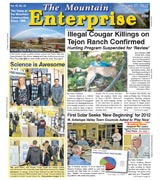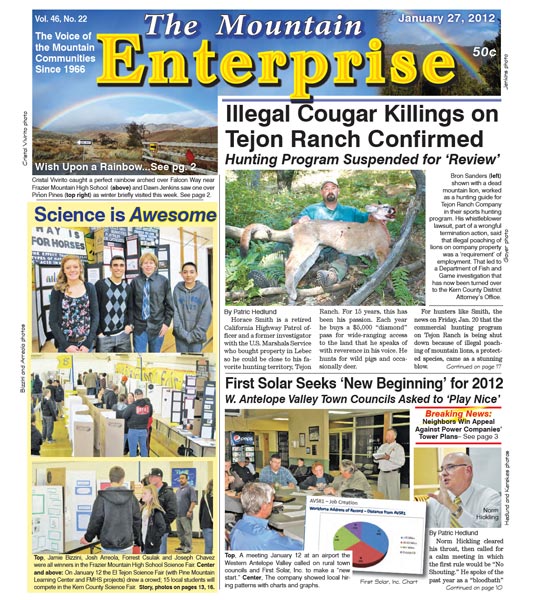![A meeting January 12 at an airport the Western Antelope Valley called on rural town councils and First Solar, Inc. to make a new start. [Hedlund photo]](https://mountainenterprise.com/fds/images/story/fs_9810.jpg)
A meeting January 12 at an airport the Western Antelope Valley called on rural town councils and First Solar, Inc. to make a new start. [Hedlund photo]
W. Antelope Valley Town Councils Asked to ‘Play Nice’
By Patric Hedlund
Norm Hickling cleared his throat, then called for a calm meeting in which the first rule would be “No Shouting.” He spoke of the past year as a “bloodbath” and no, this was not a gathering of WWE’s Extreme Smackdown wrestlers. Hickling is Los Angeles County District 5 Supervisor Michael Antonovich’s field deputy to the Western Antelope Valley.
He had invited rural town council members to what he called a “secret meeting at an airport” among people whose attempts to meet in 2011 had “spun out of control.”
That included active members of the Antelope Acres, Oso (Neenach) and Fairmont town council regions, along with executives of First Solar, Inc.— one of the first two renewable energy companies to receive authorization to begin building a solar farm. Antelope Valley Solar Ranch One (AVSR1) is the name of that project, located in the Fairmont-Neenach area near 170th Street West and Highway 138. It is about 15 miles west of Antelope Acres.
Because First Solar executives developed relationships with Antelope Acres during the permitting process (and received their support with the L.A. County Planning Commission), Oso and Fairmont complained bitterly that it was a political alliance rather than a sincere attempt to work with the people whose lives will be most changed by the utility- scale solar facility.
Increased traffic, the visual blight of endless 9-foot chain link fences “topped with razor wire” shutting off what were once wide open vistas, fire dangers and other stakeholder questions were largely left unsettled.
When it was reported that First Solar had given $200,000— $60,000 in grants to community organizations and $140,000 in a “community benefit gift”—to Antelope Acres, without ever “coming to meet” Fairmont or Oso councils, anger became intense. Other feuds arose about council boundary lines and about hiring plans at AVSR1.
Oso Town Council was insistent that qualified local labor be given first access to what was initially said to be about 350 “prevailing wage” construction jobs (about $42 an hour). In fact, about half of that number were hired—and 37 of those were laid off without warning on December 30.
Now, at the dawn of 2012, Hickling was asking everyone to “start fresh.”
He invited First Solar to present a proposal to close the animosity gap between town councils. He introduced First Solar’s senior vice president of government affairs, James Woodruff, who made a proposal to press the reset button on the community benefit gifts.
Woodruff suggested that the first $140,000 to Antelope Acres be converted into a scholarship fund administered by Antelope Valley College to benefit students from the entire area.
Then he whipped out a brand new check for $140,000, suggesting it be invested in a revolving fund administered by a committee comprised of people from each of the town councils, with the help of what he called CalFund (which is the website for the $1.24 billion endowed California Communities Foundation, based in downtown Los Angeles). There was less than immediate enthusiasm for the proposal among the 25 people in the room.
Some suggested there is an urgent need for a fire station, paramedic ambulance and a sheriff’s’ substation in the area. Pat Chiodo of the Fairmont Council mentioned the fire at the AVSR1 facility last summer and a theft of copper wire that occurred recently for which first responders took 45 to 90 minutes to arrive.
Since power from AVSR1 is going to Los Angeles and it can still cost $25,000 just to bring service to a lot in the rural region, an Antelope Acres woman said perhaps solar panels could be allocated to all residents so they could generate their own electricity. Someone else suggested a monthly stipend to help people with their utility bills.
Fairmont Town Council President David Kerr, sounding battle- weary, said of the committee concept, “people would be at each others’ throats.” He noted that small grants would mean a lot to individual students, but wouldn’t go far toward securing a fire station. It was agreed to discuss ideas with constituents and return to the issue on February 7.
The second half of the meeting introduced new players on the First Solar team, who vowed to be more forthcoming with information of concern to the community, such as how much water is being pumped at the 2,100 acre construction site.
New project manager Larry Whittet was introduced. He said he would be the new local point man for the project.
Senior Vice President Jim Lamon, international head of engineering, procurement and construction, explained the recent layoffs of local workers was preplanned. He made projections about local hiring in April.
He said the company had not understood that zip codes in this area can be misleading. The AVSR1 plant and its neighbors are closer to Lebec’s 93243 and Frazier Park’s 93225 than they are to Lancaster which has their shared zip code of 93535. Lamon’s chart showed that 55 of the 158 employees live within 30 miles of the project and 46 reside within 60 miles. Union electricians are being hired from a Lancaster union hall.
This is part of the January 27, 2012 online edition of The Mountain Enterprise.
Have an opinion on this matter? We'd like to hear from you.


